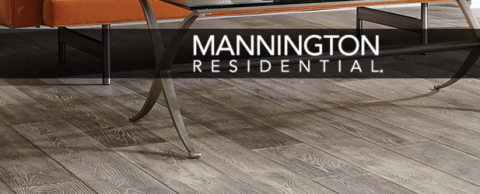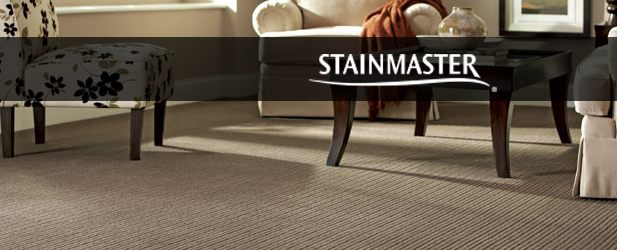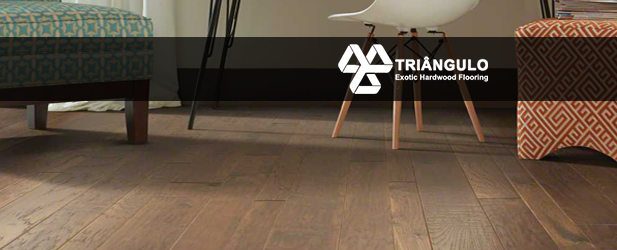Have you ever walked into a room and immediately felt calm—or stepped into another and suddenly felt more awake and energized? It’s not just the wall color or décor influencing that reaction. Your flooring has a much bigger impact on a room’s mood than most people realize.
We usually obsess over paint colors, furniture, or artwork when decorating, but the floor is what grounds the space—literally and emotionally. The color you choose underfoot can shape how a room feels: dark floors add drama and cozy elegance, light tones open up a space and brighten your mindset, and warmer shades can wrap a room in comfort. Flooring works together with your walls, furniture, and lighting to create the overall “vibe” long before you realize what’s doing the influencing.
In this guide, we’ll break down how floor colors and tones impact mood—and help you choose the right flooring for the feeling you want each room in your home to have.
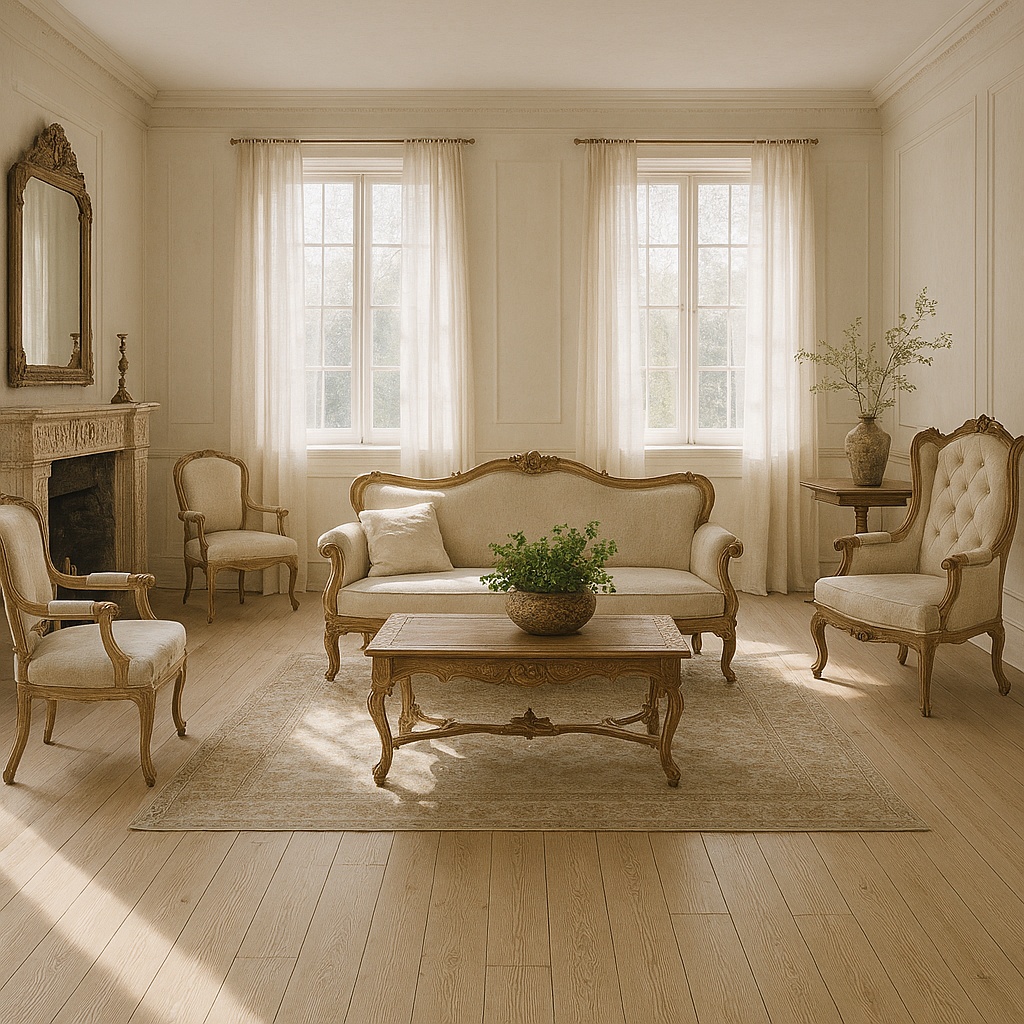
White oak floors brighten a living room effortlessly—natural light, soft neutrals, and simple décor create a calm, welcoming space.
Light & Neutral Tones
Light and neutral flooring tones are popular for more than just style—they have a real emotional effect. These shades reflect more light, which can instantly make a room feel open, uplifting, and positive. Light floors often create a sense of freshness that boosts energy, clarity, and even productivity. Neutral tones, like soft beige or warm cream, bring a calming balance that helps you feel relaxed, centered, and at ease.
What to Consider
Think about how you want people to feel when they enter the space.
A foyer or hallway with pale laminate or white oak flooring creates a bright, welcoming first impression. In kitchens, light maple gives a clean, modern, “fresh start to the day” feel, while a soft gray-toned laminate (like “Knight Tile”) adds a sense of calm and order.
Light and neutral floors can also make smaller rooms feel larger and brighter, which naturally lifts mood. If your goal is a space that feels positive, airy, and mentally refreshing, light tones create the perfect emotional backdrop.
Medium Tones
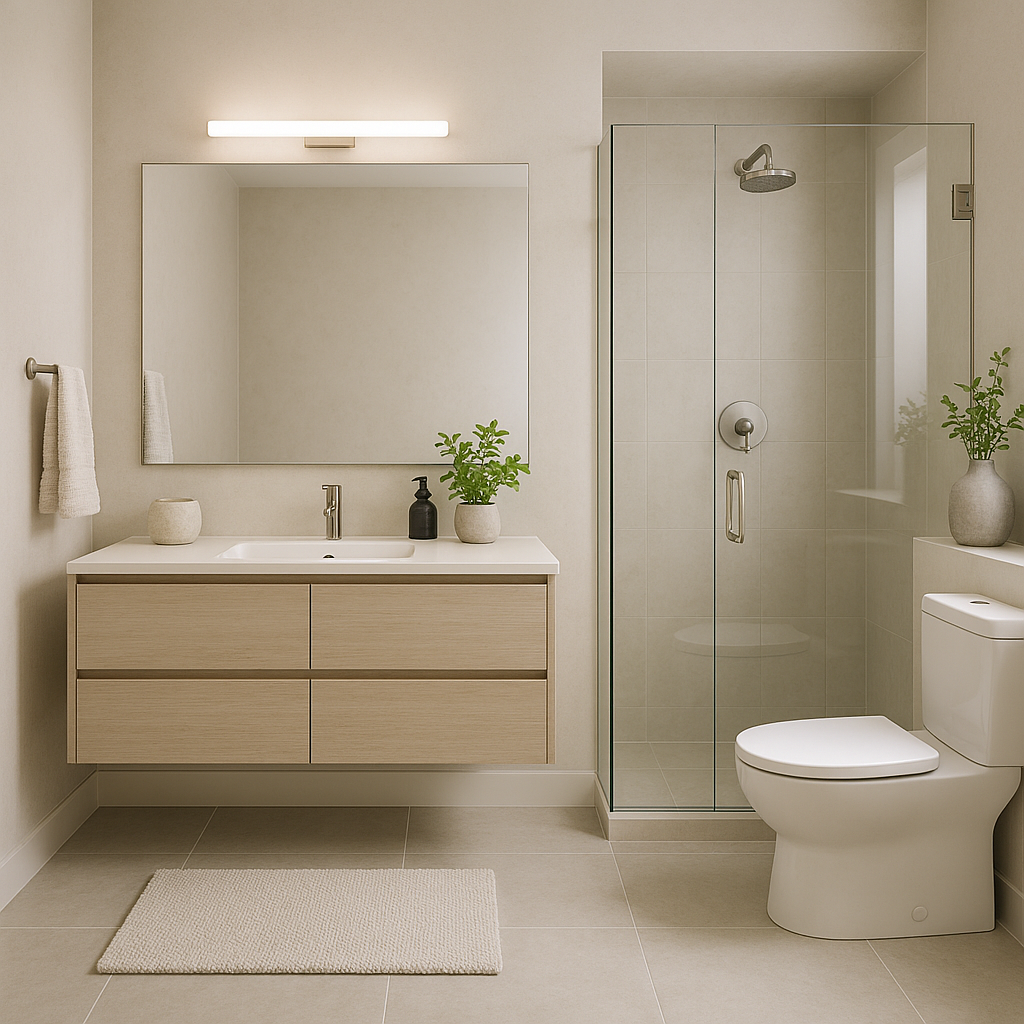
Mid-tone greige flooring brings natural warmth and balance to a bathroom, creating a spa-calm space without feeling cold or overly minimal.
Medium-toned flooring—think honey oak, warm maple, or a soft beige carpet—is the quiet MVP of interior design. These tones sit comfortably in the middle: not too bold, not too bright, and incredibly easy to work with. Emotionally, medium tones create a sense of warmth, comfort, and balance. They help a room feel grounded and inviting without overpowering the space.
What to Consider
Medium tones give you the most flexibility when decorating.
If you love color and want to use bold accents, medium flooring provides a neutral base that doesn’t compete. Prefer a soft, cozy, minimalist look? They support that too. From a beige Berber carpet to honey oak hardwood, these tones adapt beautifully to different moods and styles.
They work especially well in family rooms, living rooms, and bedrooms—spaces where comfort and connection matter. Medium floors make a room feel lived-in, warm, and effortlessly welcoming, no matter how your décor evolves over time.
Dark Tones

Dark espresso hardwood floors bring a cozy, moody elegance to this modern kitchen—warm lighting and gold accents make the space feel refined and luxurious.
Bold and brave best describe dark-toned flooring. From rich espresso brown to the beautiful simplicity of charcoal, dark floors instantly add drama and depth to a room. They create a more grounded, intimate atmosphere, making spaces feel cozy, refined, and full of character. Psychologically, darker tones offer a sense of stability and sophistication—they can make a room feel elegant, secure, and thoughtfully designed.
What to Consider
Dark flooring works especially well in spaces where you want a sense of elegance or relaxation. Living rooms, dining rooms, and bedrooms benefit from the dramatic mood that dark wood or dark-toned LVP creates. If your décor leans modern, dark tones pair beautifully with lighter walls and minimalist accents for a chic, high-contrast look.
Just keep in mind: darker floors absorb more light, which can make a room feel smaller or cozier depending on your lighting. If your goal is warmth, intimacy, or a touch of drama, dark tones set the perfect emotional stage.
If your goal is a polished, dramatic look—think modern luxury, moody elegance, or classic upscale charm—dark tones are a perfect match. They naturally highlight lighter décor, show off metallic accents, and pair wonderfully with rich textiles like velvet, leather, and wool. Whether you want a sleek contemporary space or a cozy library-like retreat, dark floors lay the foundation for a warm, stylish, and intimate design.
Monochromatic Flooring & Color Schemes

A sage monochromatic palette creates a charming, calming den with a cohesive and delightfully curated feel.
Monochromatic color schemes are a simple and effective way to create a space that feels calm, cohesive, and intentionally designed. Instead of mixing several different colors, this style uses various shades within the same color family—lighter, darker, warmer, or cooler—to maintain a consistent and relaxing flow throughout the room.
Because everything feels connected, monochromatic spaces tend to be visually soothing. They’re especially great if you want a clean, modern look without the room feeling plain or overly minimal.
What to Consider
The magic of a monochromatic design comes from texture, depth, and tone variation—not from strong color contrasts.
For example:
-
Light oak flooring paired with soft cream walls and natural fabrics creates a peaceful, spa-like atmosphere.
-
Warm mid-tone greige floors with taupe or sand-colored décor feel welcoming and balanced—perfect for living rooms or family spaces.
-
Charcoal or espresso flooring with deeper wall tones and plush textiles creates a moody, cozy vibe ideal for bedrooms, dens, or media rooms.
-
Colored carpets can also set a striking visual tone—depending on the shade, they can give a room a strong sense of personality, playfulness, or sophistication.
To keep the room from feeling flat, mix textures: pair hardwood with a woven rug, matte finishes with soft fabrics, or smooth flooring with natural elements like wood, stone, or linen. These subtle variations keep the eye engaged while still maintaining the calm, unified feel of a single-palette space.
Monochromatic design is a great choice if you want a home that feels harmonious and effortless. It works beautifully in main living areas, but it can also transform side rooms or dens into unique, purposeful spaces that feel “put together” without needing much décor.
Ready to create a space that feels truly “you”? Our team at American Carpet Wholesalers is here to help you find the perfect flooring tone to match your home’s personality. Visit our Dalton showroom or reach out for a free design consultation—we’ll guide you every step of the way.



